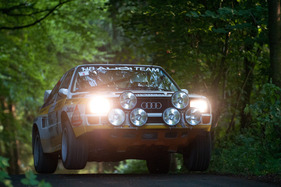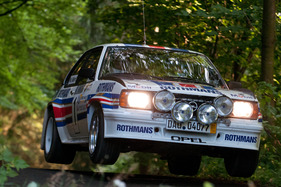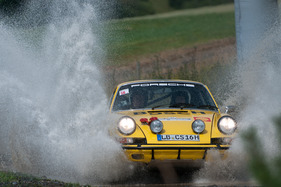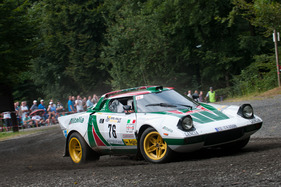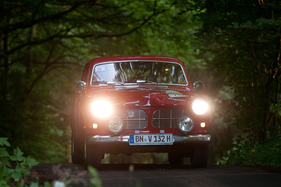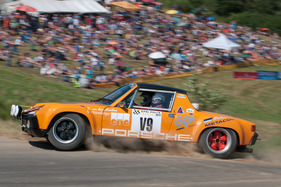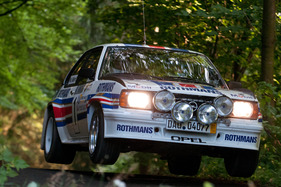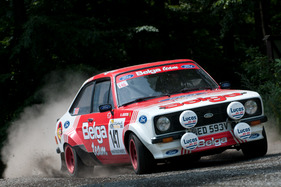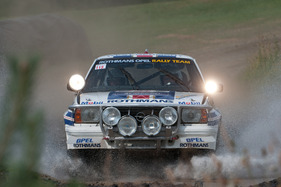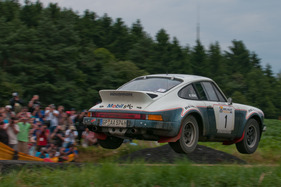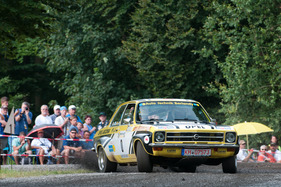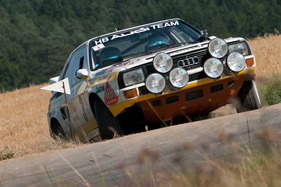Over 40,000 rally fans from several countries came to the Vulkaneifel at the weekend to watch the "40 years of the World Rally Championship" anniversary edition live. It was not only the record-breaking heat predicted by the weather forecasters that attracted spectators, but much more the extremely broad starting field: over 160 historic rally cars from 50 years of rally sport, 33 different brands, 75 different vehicle types and a number of rally racing legends!
All the ingredients were there to attract rally fans from all over Europe. In addition to Italy, France, Switzerland, Austria, Belgium, Luxembourg and Holland, there were even fans from Poland. A group from Sweden also raved about the variety of vehicles, which they would never see in their home country. One even traveled from Australia (probably not just for one weekend, but still!).
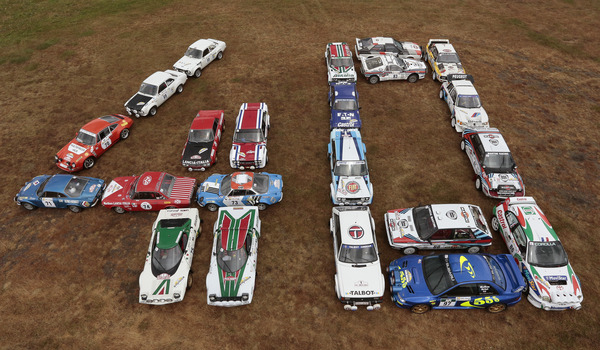
Daun as the pumping heart of the rally
Even during the journey to the Vulkaneifel town of Daun, you were visually prepared for the race weekend. Along the roads, you could always see a rally car parked that you would see live on a special stage in a few hours.
The closer you got to the center of Daun, the denser the rally atmosphere became.
There was a lot going on along Leopoldstraße, the so-called rally mile. Right next to the start-finish ramp was the podium, where spectators were able to get autographs on Thursday and Friday. Walter Röhrl was flat on Thursday after his autograph session (which probably lasted longer than an hour): "After what I've already signed here today, we can skip the autograph session tomorrow in Daun, nobody can actually come anymore."
The rally mile was also the place from where the vehicles had the official start to drive to the special stage.
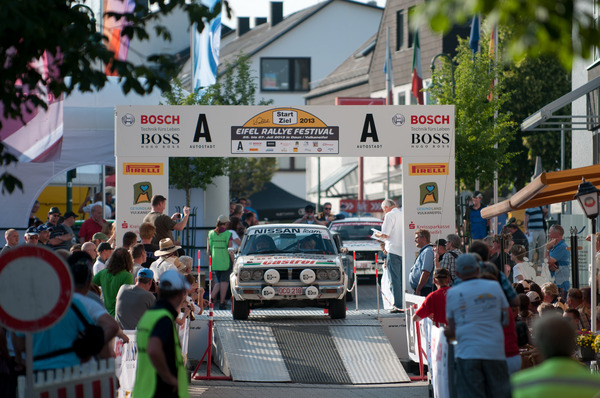
Lots of celebrities in original vehicles
Of course, many fans came because of the three main protagonists: the rally world champions Walter Röhrl, Stig Blomqvist and Björn Waldegård. While Röhrl switched between the two Group 4 cars Rothmans-Opel Ascona and Pirelli-Porsche 911 SC, Waldegard chased behind in the Mercedes 500 SL.
But other prominent drivers were also at the start. Seven-time German rally champion and Skoda works driver Matthias Kahle promised the fans: "Our Skoda 130RS is certainly not the most powerful car in the field. But I'll drive as long as the power lasts!". Harald Demuth, the two-time German rally champion, added, "It's just brilliant what's going on here, you drive through a real trellis of fans!". Simo Lampinen, who won the Finnish rally championship twice and won a class victory at Le Mans in 1965, was also visibly delighted: "I can meet so many friends here and also see such great cars from my active days. Unique!". He started in a Lancia Beta Coupe. Belgian celebrities were also at the start, including the three-time winner of the Belgian rally championship (1986, 87, 92) and European champion in 1990: Robert Droogmans. He took his original car from 1981 with him to the Vulkaneifel: the Ford Escort RS1800 in the "Belga" livery, which is very popular with fans!
Only men?
Insiders know: Rallying is not just a male domain. There were also a few female drivers at the start, such as the Swede Susanne Kottulinsky, who addressed the spectators in a special outfit at the shakedown (Thursday): "The helmet is my father's, the gloves are my son's, the shoes are my daughter's - even if they are a bit small - only the overall is mine. And I really step on the gas in the combination."
But there were also familiar faces off the track, such as that of Walter Röhrl's co-pilot, Christian Geistdörfer. This was not too surprising, however, as he has the role of marketer within the Eifel Rallye organization and was also allowed to take on several mandates during the event.
Challenging special stages - spoiled for choice
In contrast to a circuit event such as the Nürburgring or Hockenheimring, spectators at a rally festival have to prepare themselves a little, as they have to choose the best spectator seats. The whole race takes place on different so-called special stages, which are geographically located around Daun, but can be up to 15 minutes apart by car. And because the special stages overlap at times, you can't be there for every run. Some special stages are designed as a circuit, where the rally participants complete two laps. And as the start and finish are often not at the same place, there are some spectator areas where the vehicles even pass three times!
As a visitor, you are spoiled for choice: What is important to you? A wide view or close to the track? Asphalt, sand, gravel, jumps or even water passages? Do you want to see speed or wide drifts? Hairpin bends are also great, but so are dark forest passages! Fortunately, the Eifel Rallye Festival lasts three whole days, enough time to experience lots of different things!
If you couldn't quite satisfy your rally hunger, there's at least one consolation: make a note of next year's date in your calendar now!
Brand paradise
The main reason for the variety of makes and models is that the Eifel Rallye Festival takes place without timekeeping. This allows the drivers almost unlimited freedom in their choice of vehicle. Participants can drive the car of their heart or choose vehicles that are not too expensive.
The result is a starting field with vehicles from over 50 years of rally history, which is not only a pleasure for the spectators! Finnish VIP participant Harri Toivonen, who was in the Eifel for the first time in an Opel Manta 400, said enthusiastically: "When I drove to the start of the first stage on Saturday morning and saw the row of great cars I was standing in, it was absolutely amazing! And I can already promise one thing: I'll be back!".
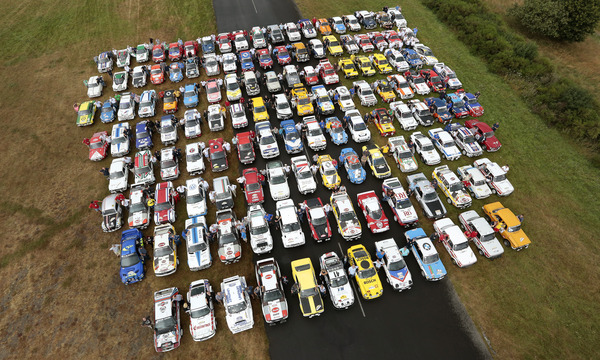
Breakdowns instead of accidents - fans in action
At motorsport events with a tightly packed field of drivers, collisions or even accidents occur time and again. In a rally, the vehicles start one after the other at regular intervals. Accidents as a result of collisions are very rare, and not at the Eifel Rallye Festival anyway: the participants do not race against the clock. Nevertheless, they usually go full throttle, which can sometimes end with an unintentional drift in the wrong direction, such as the Alfa Romeo GTV that was unable to control the vehicle after the hairpin bend at the exit of Sarmersbach.
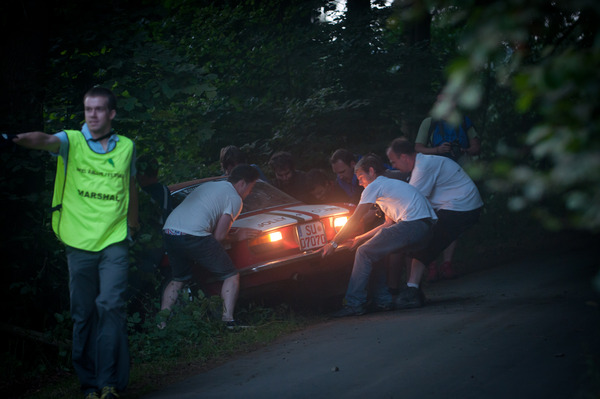
In such situations, extreme caution is required and following vehicles must be warned by the marshals with a yellow flag. In confusing stretches of road like this one, several marshals are often needed. Few personnel are left to help the driver get back on the track. It wasn't long before support was mobilized from the public. A group of fans ran to help and pulled the vehicle out of the bushes within a minute.
Fans support the teams
"I think the rally scene has realized that the history of rallying has a value and that this must be preserved," explains Reinhard Kein (head of Slowly Sideways, from whose ranks the historic rally cars come). "Unique things are happening here this weekend. On Friday, two participants lost a headlight and the other a front axle spring on the gravel of the Bosch Super Stage. Fans found them and didn't take them home as souvenirs but brought them back to the teams so that they could continue to take part here."
The most beautiful rally cars from a spectator's perspective
The most beautiful car of the Eifel Rallye Festival was officially searched for. The fans were able to award stars to their favorite via mobile application to help it triumph. Almost 10,000 stars were awarded over the course of the three festival days.
The biggest "shower of stars" went to the Triumph TR7 V8 of Dutch drivers Rob de Vos and Marcel Benning with start number 103.
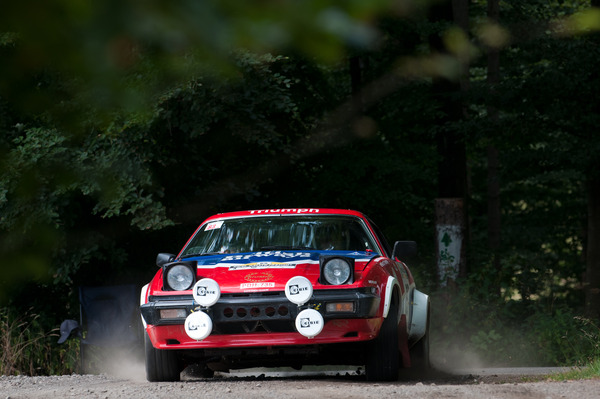
Second place went to Ralf Kleinemenke and Hans-Bernd Böing in their Volvo PV544 with start number 17.
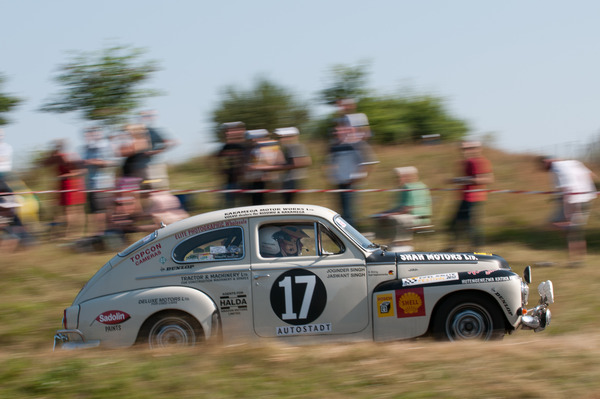
Third place went to the Lancia Stratos with Claus Aulenbacher and Andreas Mirow with start number 76.
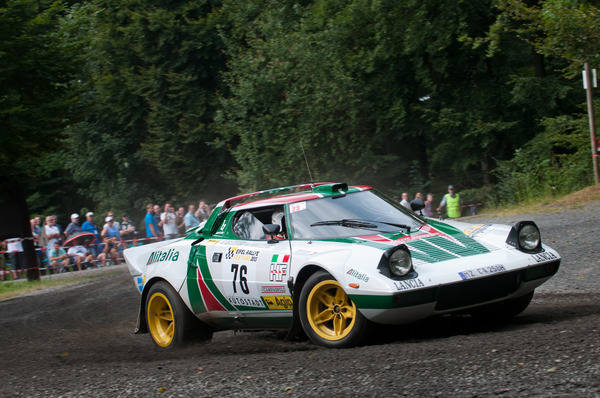
However, if you were to choose the vehicle that was roared the loudest by the fans, it would have been a completely different one! However, as there was no technical equipment to measure decibels, we cannot name a single vehicle, but the Opel brand was clearly ahead! It wasn't just Walter Röhrl in the Opel Ascona 400 that was shouted at the top of his voice, all hell broke loose in all the other Opels too! Perhaps also because the Opel drivers had by far the best drifts on the gravel...
Free Quattro sauna
Harald Demuth, the two-time German rally champion, had a free sauna installed in his Audi Sport Quattro at the weekend. "To prevent the engine from overheating in the high outside temperatures, the heating in our Quattro is turned up all the way. The temperatures are like in a sauna." With a wink, he adds: "My passengers were sweating too, but I think it was for other reasons."
Perfectly organized
The organizer of the Eifel Rallye Festival deserves the highest praise. The program booklet is extremely detailed and describes all the spectator areas with their characteristics, but also each vehicle at the start is documented with 2 pictures (then and now). But of course the praise is not only for the program booklet! Thanks to the good routing, the journeys to the spectator areas were mostly smooth and there was usually a sausage stand on site to cool down hot heads with beer or water. Large barbecues were set up for the hungry fans. Many will now think that such a kiosk in the great outdoors is primarily a money-making machine. But here, too, we were pleasantly surprised that we only had to pay €1 for a bottle of water. We hope it stays that way!
Eifel Rallye Festival 2014
An event like this is simply brilliant and can be warmly recommended. Even fans of asphalt racing should take the time to take part in such an event. What an experience!
Are you missing photos of a particular vehicle?
Then simply get in touch with us via the contact form. We look forward to hearing from you.

![Audi Sport Quattro (1985) von Harald Demuth im Wald ausgangs Sarmersbach [Originalfahrzeug Röhrl]](/bild/Audi-Sport-Quattro-1985-von-Harald-Demuth-im-Wald-ausgangs-Sarmersbach-Originalfahrzeug-Roehrl/e5d56d96-8b69-41bd-9908-1acafe54776e-normal.jpg?h=JZiryNC+61GTBclmot9NyjQtkWZlxCNtcD7f2/iiH7Q=&from=carousel&urlcontext=%2Fen%2Farticles%2Fevents%2FEifel-Rallye-Festival-2013-50-Jahre-Rallye-Geschichte-auf-Schotter-Sand-und-Asphalt.html)








![Mercedes 500 SL Gruppe 4 (1980) in der VIP Fahrer Gruppe am Eifel Rallye Festival 2013 [Originalfahrzeug]](/bild/Mercedes-500-SL-Gruppe-4-1980-in-der-VIP-Fahrer-Gruppe-am-Eifel-Rallye-Festival-2013-Originalfahrzeug/098201f2-9a97-4c10-9450-598be0abedd4-big-teaser.jpg?nohash=true&from=carousel&urlcontext=%2Fen%2Farticles%2Fevents%2FEifel-Rallye-Festival-2013-50-Jahre-Rallye-Geschichte-auf-Schotter-Sand-und-Asphalt.html)
![Mercedes 500 SL Gruppe 4 (1980) in der VIP Fahrer Gruppe am Eifel Rallye Festival 2013 [Originalfahrzeug]](/bild/Mercedes-500-SL-Gruppe-4-1980-in-der-VIP-Fahrer-Gruppe-am-Eifel-Rallye-Festival-2013-Originalfahrzeug/098201f2-9a97-4c10-9450-598be0abedd4-teaser.jpg?nohash=true&from=carousel&urlcontext=%2Fen%2Farticles%2Fevents%2FEifel-Rallye-Festival-2013-50-Jahre-Rallye-Geschichte-auf-Schotter-Sand-und-Asphalt.html)










































































































































































